srImathE rAmAnujAya nama:
srImadh varavaramunayE nama:
srI vAnAchala mahAmunayE nama:
gOpAlakrishNa dhAsar (kOnAr) who was living in chennai and a sishya of
kOil kandhAdai vAdhUla aNNan swamy compiled a set of beautiful
phrases/sentences from nampiLLai‘s eedu (documented by vadakku thiruvIdhi piLLai) vyAkyAnam long ago. kOil vidhwAn srI U. vE. R
narasimhAchAryar swamy (paramapadhavAsi) wrote simple thamizh meanings
for those phrases/sentences. This book (https://docs.google.com/file/d/0ByVemcKfGLucbWJNTUMzVS1KTzA/edit?usp=sharing) was originally released on 7-1-68 and
was re-published by puthur raghurAman swamy (editior: srI sailEsa
dhayApAthram magazine). In this series we are relishing this great compilation with the english translation for the same.

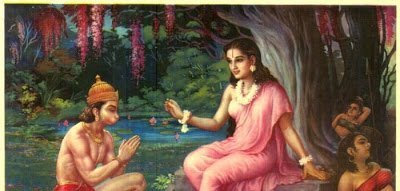
- His body is like the asOka vanikA where sIthA pirAtti was kept captive by rAvaNa.
- His attachment to sensual pleasures is like her attachment towards mArIchan (the golden deer). That attachment towards sensual pleasures will separate us from bhagavAn.
- His vision of samsAram is as dreadful as her vision of rAvaNa.
- His children, friends, etc (who are materially oriented) are like the rAkshasis who were torturing sIthA pirAtti.
- His ahankAram ahankAram, mamakAram are like the EkAkshi (One eyed rAkshasi), EkakarNi (One eared rAkshasi), etc (who are the different rAkshasis who constantly watch over sIthA pirAtti)
- His association with srIvaishNavas is like sIthA pirAtti’s association with srI vibhIshaNAzhwAn and his good-hearted daughter thrijatA.
- His vision of AchAryan is like her vision of thiruvadi (hanuman).
- AzhwArs‘ dhivyaprabhandhams and bhagavath vishayam in srI rAmAyaNam, srI mahAbhAratham, etc are like hanuman’s glorification of srI rAma’s divine qualities.
- AchAryan’s thirumanthra upadhEsam is like hanuman giving srI rAma’s ring to sIthA pirAtti.
- Always meditating on bhagavAn through thirumanthram is like sIthA pirAtti always meditating on various pastimes of her with srI rAma by seeing the ring of srI rAma.
- His activities/pastimes in samsAram will be totally different from samsAris like sIthA pirAtti’s activities/pastimes that are totally different from the residents of lankA. The residents of lankA were simply eating, sleeping, enjoying sensual pleasures, etc. pirAtti was simply longing for her re-union with bhagavAn and was filled with sorrow. She was living like a helpless deer in the midst of blood-thirsty wild-dogs.
- In spite of all these sufferings, she did not make any effort on her own since that was not proper for here true nature of pArathanthriyam. Similarly, a mumukshu never for a moment should think that he is independent and indulge in the act of protecting himself by his own effort – he should be totally surrendered to bhagavAn and fully depend on him only.
- Such mumukshus will consider bhagavAn only as the upAyam (means), constantly cry out to bhagavAn to end their miserable life in samsAram and bless them with the eternal blissful kainkaryam in srIvaikuNtam.
32. sEshikkiniyathAna vazhiyAlEyiRE sEshabhUthanukkiniyathAvathu.
சேஷிக்கினியதான வழியாலேயிறே சேஷபூதனுக்கினியதாவது.

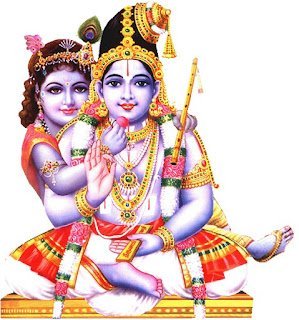
Whatever is pleasing to the master, that is pleasing to the servant as well.
33. mithunamAyk kalavA ninRAl iraNdu thalaikkum uLLa rasam sEshasEshigaL parimARRaththilumuNdiRE.
மிதுநமாய்க் கலவா நின்றால் இரண்டு தலைக்கும் உள்ள ரஸம் சேஷசேஷிகள் பரிமாற்றத்திலுமுண்டிறே.
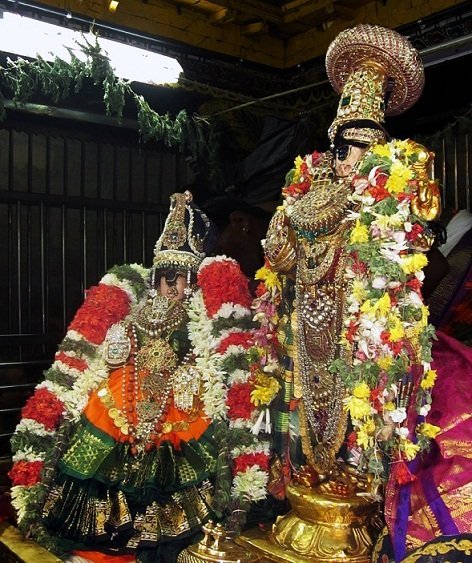
The pleasure derived by the divine couple in their courtship would also be there in the company of sEshan (jIvAthmA) and seshi (bhagavAn).
34. avanukkiniyathAy avvazhiyAlE thanakkiniyathAgaiyiRE sEsha bhUthanukku vAchi.
அவனுக்கினியதாய் அவ்வழியாலே தனக்கினியதாகையிறே சேஷ பூதனுக்கு வாசி.
It is the nature of jIvAthmA (servant) to accept what is dear to bhagavAn (master).
Translator’s note: Here “vAchi” means differentiating factor. bhagavAn is svathanthran so he can accept whatever he desires, but jIvAthmA being parathanthran, must fully follow his master’s desires.
35. bhagavath vishayaththilE OradivArA ninRavARE paragruhaththininRum svagruhaththilE pugunthAp pOlEyirukkum.
பகவத் விஷயத்திலே ஓரடிவாரா நின்றவாறே பரக்ருஹத்தினின்றும் ஸ்வக்ருஹத்திலே புகுந்தாப் போலேயிருக்கும்.
By giving up attachments to sensual pleasures and starting to engage in the matters related to bhagavAn, it is like leaving some one else’s home and entering into ones own home since bhagavath vishayam is the natural aspiration for the jIvAthmA.
36. prApthi dhEsam nithyasUrigaLitta vazhakkAy irukkum.
ப்ராப்தி தேசம் நித்யஸூரிகளிட்ட வழக்காய் இருக்கும்.
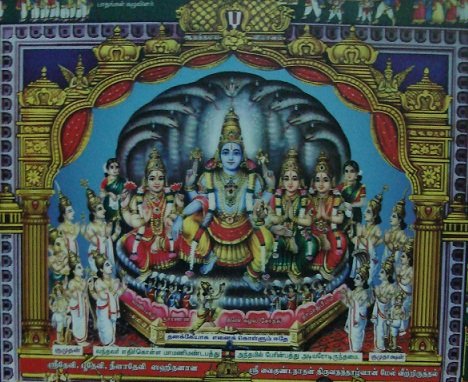
srIvaikuNtam (paramapadham) which is the ultimate destination for chEthanan (sentient being) is fully under the control of nithyasUris as identified by nammAzhwAr in thiruvAimozhi 3.9.9 as “vAnavar nAdu” (the land of nithyas/mukthas).
Translator’s note: This principle is of nithya/mukthas being the full controller of paramapadham is explained by the following pramANams.
- madhurakavi AzhwAr in his kaNNinuN chiRu thAmbu 11th pAsuram, identifies that the one who believes his words and follows AchArya nishtai will reach srIvaikuNtam. A question arises here – being fully surrendered to nammAzhwAr, why would madhurakavi AzhwAr talk about reaching out to srIvaikuNtam? All the commentators explain the reason for madhurakavi AzhwAr’s words in the following manner – since AzhwAr thirunagari is controlled by both AdhinAthan (polindhu ninRa pirAn) emperumAn and nammAzhwAr (the dhEvasthAnam is called AdhinAthar-AzhwAr dhEvasthAnam) but paramapadham is controlled fully by nammAzhwAr.
- ALavandhAr in his sthOthra rathnam 42nd slOkam, identifies that bhagavAn has given the full control of managing both nithya vibhUthi (paramapadham) and leelA vibhUthi (samsAram) to vishwaksEnar and he is simply enjoying his pastimes with srI mahAlakshmi.
37. karmavasyan piRavikkellai kANAninROm; akarmavasyan piRavikkellai kANginRilOm.
கர்மவச்யன் பிறவிக்கெல்லை காணாநின்றோம்; அகர்மவச்யன் பிறவிக்கெல்லை காண்கின்றிலோம்.
jIvAthmA who is bound by his karmA in samsAram has an end to his births when he attains liberation. But bhagavAn who is not bound by karmA and incarnates out of his causeless mercy has no end to his births.
Translator’s note:
- vEdham says ajAyamAna: bahudhA vijAyathE – bhagavAn who is birthless (by karmA) takes many births out of his mercy
- In bhagavath gIthA 4.5, krishNa (vEdhyan – Object of vEdhas) says – Both you and I have taken so many births. While I can remember every thing of my births (since I am omniscient) you cannot.
- nammAzhwAr (vaidhikar – follower of vEdhas) declares in thiruviruththam 1st pAsuram itself that, out of emperumAn‘s causeless mercy, he takes birth in to innumerable forms of life. nampiLLai identifies in his eedu vyAkyAnam that because bhagavAn incarnates out of his mercy, there is no restriction in the type of body he will accept. The same principle is identified by him in thiruvAimozhi as well in 3.10.1 – sanmam pala pala cheythu (சன்மம் பல பல செய்து – accepting many many births). Also nammAzhwAr provides a close translation for ajAyamAna: bahudhA vijAyathE in thiruvAimozhi 2.9.5 – “piRappil pal piRavip perumAn” (பிறப்பில் பல் பிறவிப் பெருமான்).
38. karmaththukku avadhiyuNdu, anugrahaththukku avadhiyillai.
கர்மத்துக்கு அவதியுண்டு, அநுக்ரஹத்துக்கு அவதியில்லை.
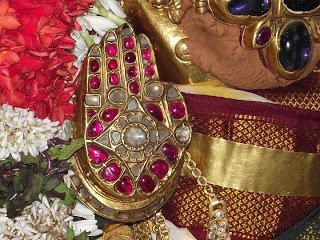
There are boundaries for jivAthmAs’ karmA. But there is no boundary for bhagavAn‘s causeless mercy.
39. palAbisandhi rahithamAga dhAnadharmaththai anushtiththu, emperumAnai udhdhEsyamAkkAthE, palAbisandhi yukthamAga anushtiththu svargAdhi bOgangaLaip paRRinAl nilai nillAthu.
பலாபிஸந்தி ரஹிதமாக தாநதர்மத்தை அநுஷ்டித்து, எம்பெருமானை உத்தேச்யமாக்காதே, பலாபிஸந்தி யுக்தமாக அநுஷ்டித்து ஸ்வர்காதி போகங்களைப் பற்றினால் நிலை நில்லாது.
Virtuous activities, Charity, etc must be performed as kainkaryam towards emperumAn without any attachment towards the result. If it was done with specific attachment towards achieving svargam (heavenly planets), etc., the results are impermanent and insignificant.
40. sEshabhUthan paRRuvathu sEshiyinudaiya thiruvadigaLaiyiRE.
சேஷபூதன் பற்றுவது சேஷியினுடைய திருவடிகளையிறே.
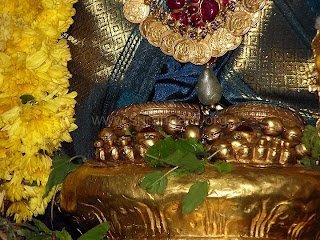
jIvAthmA (servant) will only take refuge at the lotus feet of bhagavAn (master).
Translator’s note: This principle is explained with nice examples by piLLai lOkAchAryar.
- mumukshuppadi 147 – dhvaya prakaraNam charaNau (thiruvadi/lotus feet) sabdham – sEshipakkal sEshabhUthan izhiyum thuRai; prajai mulaiyilE vAy vaikkumA pOlE (சேஷிபக்கல் சேஷபூதன் இழியும் துறை; ப்ரஜை முலையிலே வாய் வைக்குமா போலே) – Just like an infant will naturally look out for the breast of his/her mother (since that is the source of sustainance/nourishment), jIvAthmA will naturally look out for the lotus feet of bhagavAn.
- srIvachana bhUshaNam 427 – AchArya vaibhavam – Isvaranaip paRRugai kaiyaip pidiththuk kAryam koLLumO pAthi; AchAryanaip paRRugai kAlaip pidiththuk kAryam koLLumO pAthi. (ஈச்வரனைப் பற்றுகை கையைப் பிடித்துக் கார்யம் கொள்ளுமோ பாதி; ஆசார்யனைப் பற்றுகை காலைப் பிடித்துக் கார்யம் கொள்ளுமோ பாதி.) – Approaching bhagavAn directly is like reaching out to his hands (which may or may not succeed); Approaching bhagavAn through AchAryas is like reaching out to his lotus feet (which is sure to succeed) – Here AchAryas are established as the lotus feet of bhagavAn.
Full series can be viewed at: https://granthams.koyil.org/divine-revelations-of-lokacharya-english/.
archived in https://granthams.koyil.org, also visit https://acharyas.koyil.org, https://sriperumbuthur.blogspot.com
In hindi: https://granthams.koyil.org/2016/10/30/divine-revelations-of-lokacharya-4-hindi/